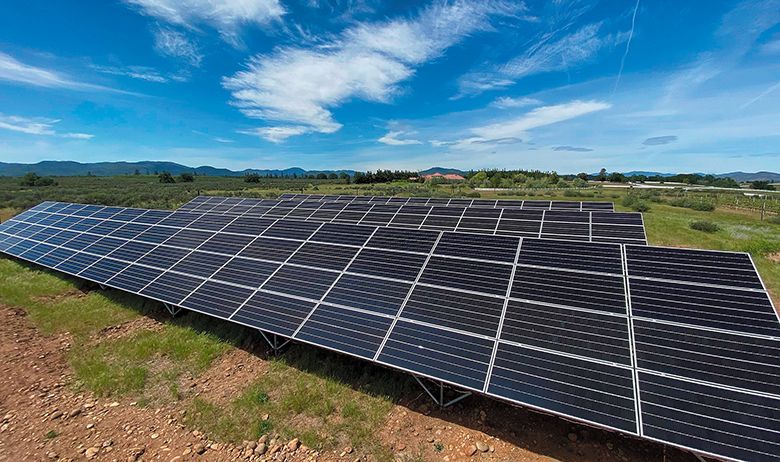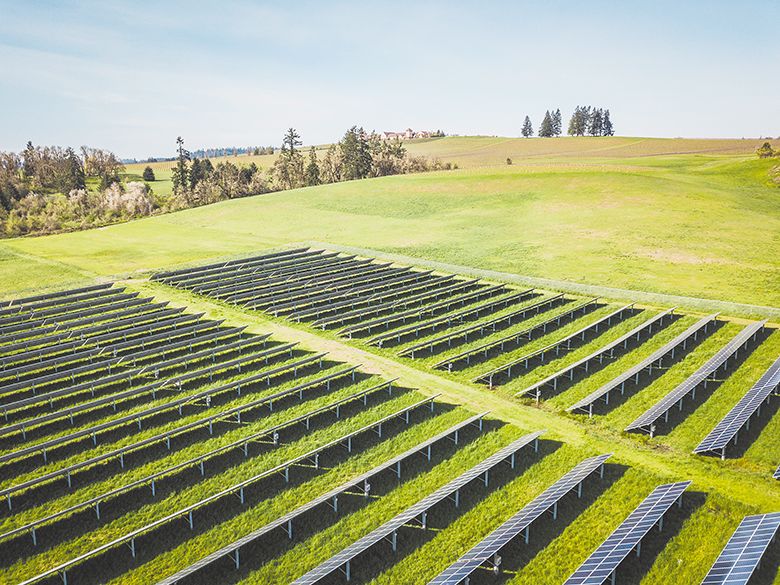Sol Searching
Oregon wineries harness energy from the sun


By Paula Bandy
Solar creating balance acts as integrative harmony in a flourishing ecosystem.
~from Tao Te Ching
Solar remains the most abundant renewable energy source. The sun is necessary to maintain all forms of life. Grapes need sunshine. Italian astronomer Galileo Galilei famously declared, “Wine is sunlight, held together by water.”
To generate heat, solar thermal technology captures the sun’s rays while photovoltaic systems convert sunlight directly into electricity. These innovations are pivotal in generating power and supporting sustainable practices, particularly in the wine industry. By using solar, vineyards create sustainable environments for wine production, required for irrigation, climate control and powering grid systems.
Several wineries embrace a solar future.
King Estate Winery
In 2011, Lane Electric embarked on a pioneering venture by installing an expansive 4,144 ground-mounted photovoltaic panels on four acres at King Estate Winery in Oregon’s Willamette Valley. This initiative stands as an emblem of innovation, being the premier and, to date, only utility-scale array boasting a striking capacity of one megawatt in Lane Electric’s service domain.
These state-of-the-art panels harness the sun’s intensity, seamlessly integrating it into the public power grid. In fact, they offer the potential to offset 76 percent of the winery’s total energy requirements. King Estate’s winery maintenance manager, Rodney Cluff, says, “The winery building alone consumed 1,478,594 kWh last year.” The panels produce enough electricity annually to offset power for 100 nearby homes, comparable to eliminating about 38 million pounds of carbon dioxide over 25 years.
In collaboration, King Estate continues to host the array on its land, without financial compensation or any reduction in the winery’s energy expenses. Demonstrating King Estate’s unwavering dedication to environmental responsibility, Jenny Ulum, the winery’s chief communications officer, expressed, “We were glad to partner with Lane Electric to make it happen because it was the right thing to do.”
King Estate has been the largest certified biodynamic vineyard in North America for nearly a decade. Along with habitat preservation, the winery maintains the vineyards without irrigation and provides several raptor boxes for rehabilitated owls and American kestrels. Such cooperation among Lane Electric, King Estate, renewable energy and the natural world embodies extraordinary harmony in pursuing progress.
Padigan
In 2016, Padigan became the first Rogue Valley winery to invest in a solar system. The panels, installed by Advanced Energy Systems, supply about 75 percent of the power required by the facility. Panels cover roughly half the available roof space, with the option for more. Kiley Evans, Padigan’s winemaker, says, “It has worked flawlessly. Not only does it generate energy, but also shades that portion of the roofline, helping to conserve winery power. With less exposed roof, it’s not as hot, thereby reducing the amount of energy required for refrigeration. There are layers to the advantages.”
Padigan’s decision to use solar panels not only demonstrates technological capability, but also a commitment to environmental responsibility. It’s about making an impact where it matters most. Evans says, “It would be wonderful to lead that effort in the Valley.”
Clearly defining the rationale for using solar panels, Padigan maximizes the impact of its environmental initiative, while continuously planning for a livable future.
“It’s one of those things you don’t do because you can, but rather because you should,” Evans says.
Kriselle Cellars
Kriselle Cellars’ Rogue Valley tasting room and wine production facility are both powered by four solar ground arrays. Their presence confirms the winery’s commitment to environmentally-conscious viability and innovation. Nora Lancaster, Kriselle’s director and partner, explains, “We elected to do this because we are so blessed with this beautiful ranch and property between the Rogue River and Upper Table Rock. We feel strongly it’s ours to protect and nurture– and take our stewardship seriously.”
The True South Solar panels generate all the winery’s power, achieved by stored credits for wintertime. Lancaster says, “Kriselle Cellars is not alone in recognizing Southern Oregon is a precious place. We have resources that can work for and not against us. We live in the land of sunshine so it behooves us to consider these kinds of projects because this centers us in the future of winemaking.”
Her declaration underscores the winery’s progressive character and dedication to harnessing local resources for a vibrant future.
Belle Fiore Winery
In the heart of Rogue Valley’s southern rolling vineyards, Belle Fiore Winery embraces a new era of continuous energy. The sunlit grapes dancing in the gentle breeze claim a partner– the shimmering solar panels on the winery’s roof.
Two years ago, Purelight Power installed over 500 solar panels, transforming the winery building into a lodestar of eco-supportive innovation. With each panel soaking up the sun’s rays, the massive array generates over 250 kilowatts of energy, enough to power all winery facilities, including the tasting room. Facing both south and west, the winery expands its solar power while capturing ideal daily sun movement.
This balance of sun and science enhances the wine’s flavors, along with reducing energy costs, a smart investment for the future. Belle Fiore Winery is creating a story of sustainability through the vines for years to come.
Troon Vineyard
Applegate Valley’s Troon Vineyard is globally recognized for its commitment to sustainability. One of two Regenerative Organic Certified vineyards in the world, the 100-acre biodynamically-farmed property is nearly finished constructing a 7,000-square-foot “solar barn.”
The barn supports a 165-panel solar array, a natural evolution in the vineyard’s sustainable operations. With a capacity of 153 kWh, it is a significant step forward in long-term renewable energy efficiency. The barn will become the center of property’s agricultural activities, with charging available for their electric vehicles and equipment. Garret Long, Troon’s director of agriculture, explains, “Multifunctionality of solar is very important. Over the next couple years, as we continue replacing old equipment with electric, this marks a crucial transition away from our dependence on petroleum. It’s an exciting future!”
This collaboration with True South Solar took four years researching the vineyard’s past electricity usage. The solar barn’s array is designed to power the entire farm, including three homes, a tasting room with kitchen and offices, wine production facility, two car charging stations and the electricity-demanding irrigation pumps. The goal was clear– to meet or exceed the current energy needs of the vineyard.
With new solar, the future looks even brighter for Troon Vineyard’s mission to lead by example in responsible farming, winemaking and agriculture.
VibeSolar
Tracing Latitude 42º from Southern Oregon to countries bordering the Mediterranean Sea, an inventive approach to generating solar energy is gaining traction. Photovoltaic panels are sprouting up in vineyards. Cleverly named Enovoltaics, these panels harness the sun’s energy while shielding the delicate vines from its harsh glare.
Located above the vines on poles, this innovative method reduces stress on the vines while allowing humans and animals to move below. This harmonious dance of light and energy also fosters a flourishing ecosystem, life thriving in the rows beneath the elevated structures.
Enovoltaics have not yet appeared in Oregon. The rapidly fluctuating effects of climate change appear to be hitting harder in the south of France, Greece and Spain. The region continues to experience more extreme heat than Southern Oregon.
Nora Lancaster stresses the value of using the power of sunshine. She reflects on how sustainability is an integral part of our state’s identity. “Powered by Southern Oregon sunshine. Sustainability is a great part of ‘brand Oregon.’”
The feel is “VibeSolar.” Let’s celebrate the power derived from Oregon sunlight. Here, sustainability is not just a concept, but a vital thread in the rich tapestry of our collective identity. It is truly indicative of the enduring harmony between nature and innovation.
Paula Bandy, a writer transplant from the flatlands of Illinois to the mountains of Southern Oregon, is currently the bi-weekly wine columnist for Medford Mail Tribune. She’s covered wine, lifestyle, food and home for Southern Oregon Magazine, and additional national and international academic publications. She was a writer and on-air commentator for Jefferson Public Radio, the Southern Oregon University NPR affiliate, for a decade. She’s also a Certified Sherry Wine Specialist (CSWS) and jewelry designer, pb~bodyvine. Connect with her at pbthegrapevine@gmail.com.










